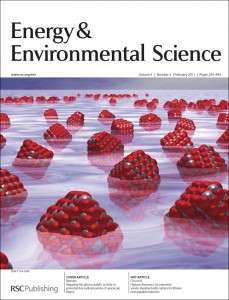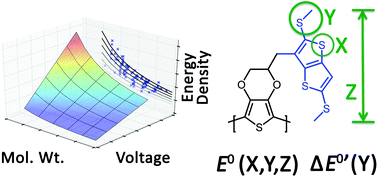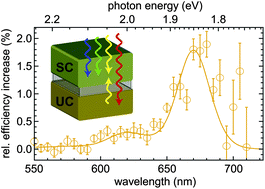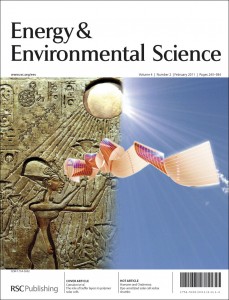 We would like to share with you some of the high impact review articles which have been published in Energy & Environmental Science (EES) in 2011.
We would like to share with you some of the high impact review articles which have been published in Energy & Environmental Science (EES) in 2011.
From authoritative Reviews to personal Perspectives and Minireviews of exciting emerging areas, EES publishes review articles of the very highest quality and impact.
On behalf of Editor-in-Chief Nathan Lewis (Caltech) we invite you to submit your best research today.
Read a selection of our high impact reviews:
Graphene-based nanomaterials for energy storage
Martin Pumera
DOI: 10.1039/C0EE00295J
CO2 capture by solid adsorbents and their applications: current status and new trends
Qiang Wang, Jizhong Luo, Ziyi Zhong and Armando Borgna
DOI: 10.1039/C0EE00064G
Recent advances in non-precious metal catalysis for oxygen-reduction reaction in polymer electrolyte fuel cells
Frédéric Jaouen, Eric Proietti, Michel Lefèvre, Régis Chenitz, Jean-Pol Dodelet, Gang Wu, Hoon Taek Chung, Christina Marie Johnston and Piotr Zelenay
DOI: 10.1039/C0EE00011F
Challenges in the development of advanced Li-ion batteries: a review
Vinodkumar Etacheri, Rotem Marom, Ran Elazari, Gregory Salitra and Doron Aurbach
DOI: 10.1039/C1EE01598B
Dye-sensitized solar cell redox shuttles
Thomas W. Hamann and Jesse W. Ondersma
DOI: 10.1039/C0EE00251H
Catalytic routes for the conversion of biomass into liquid hydrocarbon transportation fuels
Juan Carlos Serrano-Ruiz and James A. Dumesic
DOI: 10.1039/C0EE00436G
Current perspectives on gas hydrate resources
Ray Boswell and Timothy S. Collett
DOI: 10.1039/C0EE00203H
Development and challenges of LiFePO4 cathode material for lithium-ion batteries
Li-Xia Yuan, Zhao-Hui Wang, Wu-Xing Zhang, Xian-Luo Hu, Ji-Tao Chen, Yun-Hui Huang and John B. Goodenough
DOI: 10.1039/C0EE00029A
Organic non-fullerene acceptors for organic photovoltaics
Prashant Sonar, Jacelyn Pui Fong Lim and Khai Leok Chan
DOI: 10.1039/C0EE00668H
Graphene based new energy materials
Yiqing Sun, Qiong Wu and Gaoquan Shi
DOI: 10.1039/C0EE00683A
One-dimensional noble metal electrocatalysts: a promising structural paradigm for direct methanol fuel cells
Christopher Koenigsmann and Stanislaus S. Wong
DOI: 10.1039/C0EE00197J
Tandem polymer photovoltaic cells—current status, challenges and future outlook
Srinivas Sista, Ziruo Hong, Li-Min Chen and Yang Yang
DOI: 10.1039/C0EE00754D
Nanostructured silicon for high capacity lithium battery anodes
Jeannine R. Szczech and Song Jin
DOI: 10.1039/C0EE00281J
Carbon nanotubes and their composites in electrochemical applications
Grzegorz Lota, Krzysztof Fic and Elzbieta Frackowiak
DOI: 10.1039/C0EE00470G
Electrochemical CO2 sequestration in ionic liquids; a perspective
Neil V. Rees and Richard G. Compton
DOI: 10.1039/C0EE00580K
Low-platinum and platinum-free catalysts for the oxygen reduction reaction at fuel cell cathodes
Adina Morozan, Bruno Jousselme and Serge Palacin
DOI: 10.1039/C0EE00601G
Solution-derived ZnO nanostructures for photoanodes of dye-sensitized solar cells
Feng Xu and Litao Sun
DOI: 10.1039/C0EE00448K
The role of buffer layers in polymer solar cells
Riccardo Po, Chiara Carbonera, Andrea Bernardi and Nadia Camaioni
DOI: 10.1039/C0EE00273A
Semiconductor/biomolecular composites for solar energy applications
Chuanhao Li, Feng Wang and Jimmy C. Yu
DOI: 10.1039/C0EE00162G
Zeolite-catalyzed biomass conversion to fuels and chemicals
Esben Taarning, Christian M. Osmundsen, Xiaobo Yang, Bodil Voss, Simon I. Andersen and Claus H. Christensen
DOI: 10.1039/C004518G
Advanced carbon aerogels for energy applications
Juergen Biener, Michael Stadermann, Matthew Suss, Marcus A. Worsley, Monika M. Biener, Klint A. Rose and Theodore F. Baumann
DOI: 10.1039/C0EE00627K
Underneath the fascinations of carbon nanotubes and graphene nanoribbons
Wei-Tao Zheng and Chang Q Sun
DOI: 10.1039/C0EE00434K
New conjugated polymers for plastic solar cells
David Gendron and Mario Leclerc
DOI: 10.1039/C1EE01072G
You can find many more excellent reviews on our website.



















